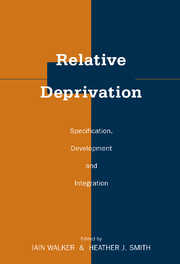Book contents
- Frontmatter
- Contents
- List of Contributors
- 1 Fifty Years of Relative Deprivation Research
- PART ONE SPECIFICATION
- PART TWO DEVELOPMENT
- 6 Personal and Group Relative Deprivation: Connecting the ‘I’ to the ‘We’
- 7 “Poisoning the Consciences of the Fortunate”: The Experience of Relative Advantage and Support for Social Equality
- 8 The Embeddedness of Social Comparison
- 9 Japanese and American Reactions to Gender Discrimination
- 10 Collective Action in Response to Disadvantage: Intergroup Perceptions, Social Identification, and Social Change
- PART THREE INTEGRATION
- Part Four Conclusion
- Index
8 - The Embeddedness of Social Comparison
Published online by Cambridge University Press: 29 September 2009
- Frontmatter
- Contents
- List of Contributors
- 1 Fifty Years of Relative Deprivation Research
- PART ONE SPECIFICATION
- PART TWO DEVELOPMENT
- 6 Personal and Group Relative Deprivation: Connecting the ‘I’ to the ‘We’
- 7 “Poisoning the Consciences of the Fortunate”: The Experience of Relative Advantage and Support for Social Equality
- 8 The Embeddedness of Social Comparison
- 9 Japanese and American Reactions to Gender Discrimination
- 10 Collective Action in Response to Disadvantage: Intergroup Perceptions, Social Identification, and Social Change
- PART THREE INTEGRATION
- Part Four Conclusion
- Index
Summary
Think about the last time you made an unscheduled visit to a physician, medical clinic, or hospital for some symptom or injury. Did you talk to anyone prior to going for medical consultation? With whom did you talk? Why? If you're like me when my foot mysteriously swelled up one morning last month, you probably talked with a relative and perhaps a friend or two. I wanted to know what they thought might be causing the swelling, whether they'd ever experienced anything like this, whether they would worry if it happened to them, and what I might do next. I learned a lot by comparing my mysterious symptoms with these social contacts: they suggested a sprain or an insect bite; that the swelling looked unusual; that, yes, they would worry if it was their foot; and that checking with the doctor at the clinic was probably a good idea. Not just any acquaintance or stranger would do for these consultations; I compared my symptoms with people I knew and trusted (though acquaintances or strangers would have done in a pinch). My comparisons were embedded in my personal social network of relatives and friends.
The answer to the question “Who compares with whom?” – a basic issue in research on social comparison – appears to have a great deal to do with “who is in contact with whom.”
- Type
- Chapter
- Information
- Relative DeprivationSpecification, Development, and Integration, pp. 164 - 184Publisher: Cambridge University PressPrint publication year: 2001
- 3
- Cited by



